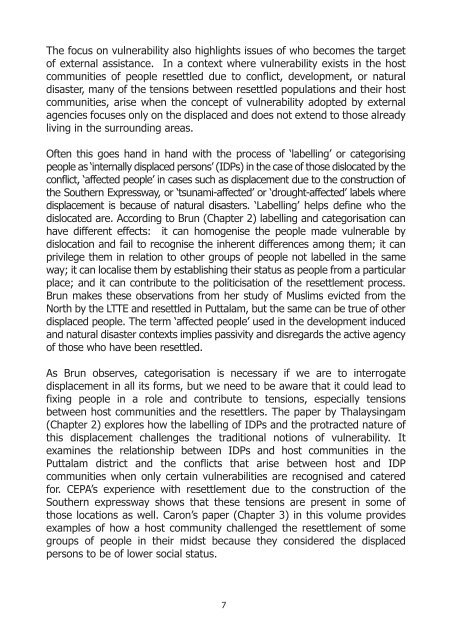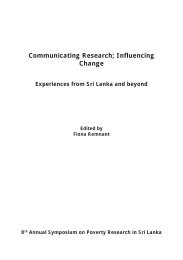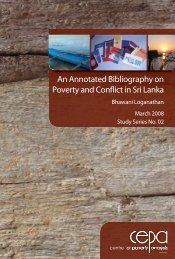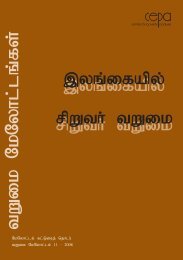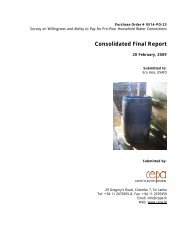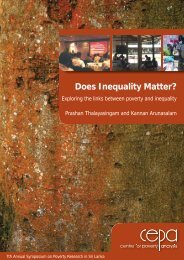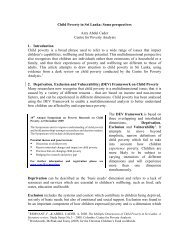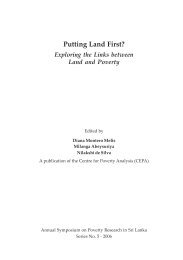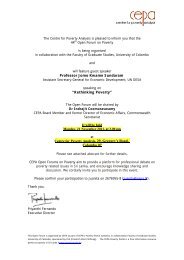Involuntary Displacement and Resettlement â Policy and ... - CEPA
Involuntary Displacement and Resettlement â Policy and ... - CEPA
Involuntary Displacement and Resettlement â Policy and ... - CEPA
- No tags were found...
Create successful ePaper yourself
Turn your PDF publications into a flip-book with our unique Google optimized e-Paper software.
The focus on vulnerability also highlights issues of who becomes the targetof external assistance. In a context where vulnerability exists in the hostcommunities of people resettled due to conflict, development, or naturaldisaster, many of the tensions between resettled populations <strong>and</strong> their hostcommunities, arise when the concept of vulnerability adopted by externalagencies focuses only on the displaced <strong>and</strong> does not extend to those alreadyliving in the surrounding areas.Often this goes h<strong>and</strong> in h<strong>and</strong> with the process of ‘labelling’ or categorisingpeople as ‘internally displaced persons’ (IDPs) in the case of those dislocated by theconflict, ‘affected people’ in cases such as displacement due to the construction ofthe Southern Expressway, or ‘tsunami-affected’ or ‘drought-affected’ labels wheredisplacement is because of natural disasters. ‘Labelling’ helps define who thedislocated are. According to Brun (Chapter 2) labelling <strong>and</strong> categorisation canhave different effects: it can homogenise the people made vulnerable bydislocation <strong>and</strong> fail to recognise the inherent differences among them; it canprivilege them in relation to other groups of people not labelled in the sameway; it can localise them by establishing their status as people from a particularplace; <strong>and</strong> it can contribute to the politicisation of the resettlement process.Brun makes these observations from her study of Muslims evicted from theNorth by the LTTE <strong>and</strong> resettled in Puttalam, but the same can be true of otherdisplaced people. The term ‘affected people’ used in the development induced<strong>and</strong> natural disaster contexts implies passivity <strong>and</strong> disregards the active agencyof those who have been resettled.As Brun observes, categorisation is necessary if we are to interrogatedisplacement in all its forms, but we need to be aware that it could lead tofixing people in a role <strong>and</strong> contribute to tensions, especially tensionsbetween host communities <strong>and</strong> the resettlers. The paper by Thalaysingam(Chapter 2) explores how the labelling of IDPs <strong>and</strong> the protracted nature ofthis displacement challenges the traditional notions of vulnerability. Itexamines the relationship between IDPs <strong>and</strong> host communities in thePuttalam district <strong>and</strong> the conflicts that arise between host <strong>and</strong> IDPcommunities when only certain vulnerabilities are recognised <strong>and</strong> cateredfor. <strong>CEPA</strong>’s experience with resettlement due to the construction of theSouthern expressway shows that these tensions are present in some ofthose locations as well. Caron’s paper (Chapter 3) in this volume providesexamples of how a host community challenged the resettlement of somegroups of people in their midst because they considered the displacedpersons to be of lower social status.7


